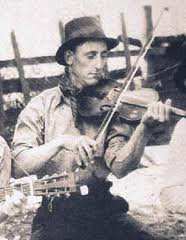Annotation:Peacock Rag: Difference between revisions
No edit summary |
No edit summary |
||
| (13 intermediate revisions by 3 users not shown) | |||
| Line 1: | Line 1: | ||
---------- | |||
---- | {{TuneAnnotation | ||
|f_tune_annotation_title= https://tunearch.org/wiki/Annotation:Peacock_Rag > | |||
'''PEACOCK RAG.''' AKA and see "[[Starlight Clog]]," "[[Nightingale (2) (The)]]," "[[Mason-Dixon Schottische (The)]]," "[[Parkersburg Landing]]," "[[Limber Neck Blues]]." | |f_annotation='''PEACOCK RAG.''' AKA and see "[[Starlight Clog]]," "[[Nightingale (2) (The)]]," "[[Mason-Dixon Schottische (The)]]," "[[Parkersburg Landing]]," "[[Limber Neck Blues]], "[[Rustic Dance (3)]]." American; Country Blues or Rag. D Major. Standard tuning (fiddle). One part (Lowinger): AABB (Brody, Christeson, Phillips): AA’BB’ (Beisswenger & McCann, Silberberg). Popularized by, and often attributed to, Arthur Smith [http://www.nationalfiddlerhalloffame.org/HallOfFame/arthursmithbio.html] (Tenn.) {1929-30}. | ||
[[File:arthursmith.jpg|200px|thumb|left|Fiddlin' Arthur Smith]] | [[File:arthursmith.jpg|200px|thumb|left|Fiddlin' Arthur Smith]] | ||
According to a story told by Jim Nelson (Fiddle-L 4.1.10) a cousin of Smith’s, a fiddler by the name of Clay Smith (Fairview Heights, Ill., although originally from middle Tennessee), learned the tune from the playing of Wade Ray, a popular radio fiddler on KMOX in St. Louis in the 1930s and 40s. Clay told Nelson that he played the tune for Arthur Smith at a family get-together back in Tennessee, and that soon after that Smith recorded it for Bluebird Records. Originally “Peacock Rag” may have been a turn of the century ragtime composition which made its way into the old-time repertoire (Dr. Charles Wolfe/B. Poss). East Kentucky fiddler Ed Hayley | According to a story told by Jim Nelson (Fiddle-L 4.1.10) a cousin of Smith’s, a fiddler by the name of Clay Smith (Fairview Heights, Ill., although originally from middle Tennessee), learned the tune from the playing of Wade Ray, a popular radio fiddler on KMOX in St. Louis in the 1930s and 40s. Clay told Nelson that he played the tune for Arthur Smith at a family get-together back in Tennessee, and that soon after that Smith recorded it for Bluebird Records. Originally “Peacock Rag” may have been a turn of the century ragtime composition which made its way into the old-time repertoire (Dr. Charles Wolfe/B. Poss). East Kentucky fiddler Ed Hayley's "[[Parkersburg Landing]]" and Mississippi musicians Narmour and Smith's "[[Limber Neck Blues]]" both have similar first strains. Some fiddlers make a point of incorporating imitations of peacock sounds into the B part of the tune | ||
|f_source_for_notated_version=Chubby Wise [Brody]: Gus Vandergriff (Pulaski County, Missouri) [Christeson]; Glenn Rickman (1901-1982, Hurley, Missouri) [Beisswenger & McCann]. | |||
|f_printed_sources=Beisswenger & McCann ('''Ozarks Fiddle Music'''), 2008; p. 112. Brody ('''Fiddler’s Fakebook'''), 1983; p. 215. R.P. Christeson ('''Old Time Fiddlers Repertory, vol. 1'''), 1973; p. 152. Lowinger ('''Bluegrass Fiddle'''), 1974; p. 24. Phillips ('''Traditional American Fiddle Tunes, vol. 2'''), 1995; p. 97. Silberberg ('''93 Tunes I Didn’t Learn at the Tractor Tavern'''), 2004; p. 34. Susan Songer with Clyde Curley ('''Portland Collection vol. 3'''), 2015; p. 159. | |||
|f_recorded_sources=American Heritage 1, Herman Johnson - "Champion Fiddling." County 547, Arthur Smith - "Fiddlin' Arthur Smith and His Dixie-Liners, vol. 2" (1978). Folkways Records FW31007, The McGee Brothers and Arthur Smith - "Milk 'Em in the Evening Blues" (1968). Gusto 104, Chubby Wise - "30 Fiddler's Greatest Hits." Montgomery Ward 8892 (78 RPM), Arthur Smith & His Dixieliners (1940). New World NW 226, Arthur Smith - "That’s My Rabbit, My Dog Caught It: Traditional Southern Instrumental Styles" (1978). | |||
|f_see_also_listing=Jane Keefer’s Folk Music Index: An Index to Recorded Sources [http://www.ibiblio.org/keefer/p03.htm#Peara]<br> | |||
Hear Arthur Smith & the Dixieliners' recording on youtube.com [https://www.youtube.com/watch?v=kE-BulpFVkQ]<br> | |||
Hear Sammie Dyer's 1972 field recording at Berea Sound Archives [https://soundarchives.berea.edu/items/show/1156]<br> | |||
}} | |||
'' | |||
Jane Keefer’s Folk Music Index: An Index to Recorded Sources []<br> | |||
<br> | |||
<br> | |||
Latest revision as of 03:52, 17 April 2023
X:1 T:Peacock Rag % Nottingham Music Database S:Folk Camps, via EF M:2/4 L:1/8 K:G F/2G/2|"D"Af-f/2e/2d|"D"A2 ^GA|"G"Bg -g/2f/2e|"E7"B2 ed| "A7"ca -a/2e/2g/2e/2|"A7"fe Bc|"D"d/2c/2d/2f/2 -"G"f/2d/2B|"A7"AF G^G| "D"Af -f/2e/2d|"D"A2 ^GA|"G"Bg -g/2f/2e|"E7"B2 ed| "A7"ca -a/2e/2g/2e/2|"A7"fe Bc|"D"d/2c/2d/2f/2 -"A7"f/2c/2e|"D"d2 a^a| "B7"bb/2^a/2 b/2a/2b|"B7"a2 gf|"E7"ee/2f/2 ^g/2b/2g/2f/2|"E7"e3d| "A7"ca -a/2e/2g/2e/2|"A7"fe Bc|"D"d/2c/2d/2f/2 -"G"f/2d/2B|"A"A2 a^a| "B7"bb/2^a/2 b/2a/2b|"B7"a2 gf "E7"ee/2f/2 ^g/2b/2g/2f/2|"E7"e3d| "A7"ca -a/2e/2g/2e/2|"A7"fe Bc|"D"d/2c/2d/2f/2 -"A7"f/2c/2e|"D"d3||
PEACOCK RAG. AKA and see "Starlight Clog," "Nightingale (2) (The)," "Mason-Dixon Schottische (The)," "Parkersburg Landing," "Limber Neck Blues, "Rustic Dance (3)." American; Country Blues or Rag. D Major. Standard tuning (fiddle). One part (Lowinger): AABB (Brody, Christeson, Phillips): AA’BB’ (Beisswenger & McCann, Silberberg). Popularized by, and often attributed to, Arthur Smith [1] (Tenn.) {1929-30}.

According to a story told by Jim Nelson (Fiddle-L 4.1.10) a cousin of Smith’s, a fiddler by the name of Clay Smith (Fairview Heights, Ill., although originally from middle Tennessee), learned the tune from the playing of Wade Ray, a popular radio fiddler on KMOX in St. Louis in the 1930s and 40s. Clay told Nelson that he played the tune for Arthur Smith at a family get-together back in Tennessee, and that soon after that Smith recorded it for Bluebird Records. Originally “Peacock Rag” may have been a turn of the century ragtime composition which made its way into the old-time repertoire (Dr. Charles Wolfe/B. Poss). East Kentucky fiddler Ed Hayley's "Parkersburg Landing" and Mississippi musicians Narmour and Smith's "Limber Neck Blues" both have similar first strains. Some fiddlers make a point of incorporating imitations of peacock sounds into the B part of the tune

